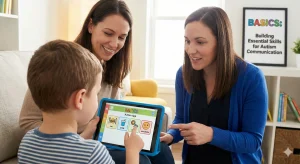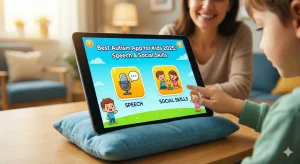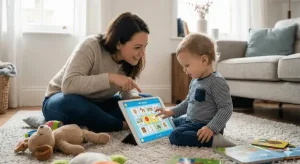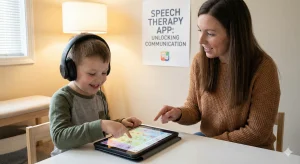Sensory Processing Disorder: How Occupational Therapy Eases Daily Struggles
By Wellness Hub
Last Updated: October 30, 2025
Every parent knows that raising a young child is filled with surprises. But for some families, simple everyday tasks — getting dressed, brushing teeth, or stepping into a noisy classroom — can feel like mountains to climb.
If your child melts down over clothing tags, avoids swings, or covers their ears at the sound of a blender, you might be seeing early signs of sensory processing difficulties.
The good news? Occupational therapy (OT) can make daily life calmer, more predictable, and much more joyful for your child — and for you. Let’s explore how.
What Is Sensory Processing Disorder (SPD)?
Sensory Processing Disorder happens when a child’s brain has trouble organizing and responding to information from the senses — touch, sound, taste, smell, sight, movement, and body awareness.
For most children, these senses work together seamlessly. For a child with SPD, signals may feel too strong, too weak, or confusing.
Some children crave constant movement and touch — they spin, crash, and jump. Others avoid it, refusing to touch sand, wear certain clothes, or go near loud noises. These behaviors aren’t misbehavior; they’re the child’s way of coping with a world that feels overwhelming or unpredictable.
In simple terms, SPD affects how children experience the world through their senses — and occupational therapy helps them make sense of it again.
Early Signs of Sensory Processing Difficulties in Children
Every child reacts differently, but there are some common red flags parents may notice between ages two and eight:
- Overreacts to touch, sound, or light (cries when hair is brushed or hates bright lights)
- Avoids certain textures, clothes, or foods
- Constantly moves, spins, or crashes into things
- Seems uncoordinated or clumsy
- Struggles with balance, climbing, or catching a ball
- Gets overwhelmed in crowds or noisy places
- Has trouble focusing, following routines, or calming down after excitement
If several of these behaviors feel familiar, you’re not alone — sensory challenges are common, especially in children with developmental differences like autism, ADHD, or anxiety. Early identification is key, because therapy works best when started early.
Why Everyday Routines Can Feel So Hard
Imagine walking into a room where the lights are blinding, every sound is amplified, and even your shirt feels like sandpaper. That’s what everyday life can feel like for a child with SPD.
Simple routines — brushing teeth, getting dressed, eating meals — involve multiple sensory steps. The taste, smell, texture, and pressure of a toothbrush or clothing seam can trigger intense discomfort or confusion.
Some children respond with tears or meltdowns; others withdraw or shut down completely.
Parents often describe feeling exhausted or guilty, wondering if they’re “doing something wrong.”
But these reactions aren’t defiance — they’re the child’s nervous system struggling to organize input.
The goal of occupational therapy is to help the brain rewire its response, so daily life feels safer and smoother.
How Occupational Therapy Helps Children With Sensory Processing Disorder
Occupational therapy bridges the gap between a child’s sensory world and their daily activities. It uses play-based, structured exercises to help the brain process sensations correctly.
Here’s how OT helps step by step:
- Assessment and Sensory Profile – The therapist first observes how the child reacts to touch, sound, movement, and visual input. Parents are often part of this stage.
- Personalized Plan – A custom “sensory diet” is designed — a daily routine of activities that give the right kind of sensory input at the right time.
- Play-Based Sensory Integration – Children engage in fun activities like swinging, jumping, climbing, or squeezing playdough to train the brain to tolerate sensations more smoothly.
- Emotional Regulation – Through calming strategies like deep breathing or heavy work, the child learns to manage big feelings before they turn into meltdowns.
- Parent Coaching – OTs guide parents on how to carry over these strategies at home and in school for consistency.
Occupational therapy doesn’t just teach children to cope — it strengthens their nervous system, builds confidence, and gives families a shared language to handle sensory challenges together.
Also read: Empower Your Autistic Child With Occupational Therapy
Inside a Sensory OT Session — What Parents Can Expect
A sensory OT session looks more like playtime than therapy — but it’s carefully designed.
Here’s what usually happens:
- Warm-up: The child might start on a swing, balance board, or trampoline to awaken their body’s sensory systems.
- Core Activities: The therapist uses tasks that challenge different senses — obstacle courses, texture bins, weighted balls, or puzzles that involve fine motor control.
- Skill Practice: Everyday goals like buttoning a shirt, using a spoon, or writing are woven into the session in playful ways.
- Cool-down: Deep-pressure hugs, slow breathing, or soft music help the child transition calmly before leaving.
Each session is adjusted based on the child’s sensory threshold — too much stimulation can overwhelm, while too little may not create progress. Over time, the brain learns to regulate more efficiently.
Occupational Therapy Techniques That Make a Difference
OTs use a variety of evidence-based techniques tailored to each child’s sensory profile:
1. Sensory Integration Therapy
Focuses on exposing the child to controlled sensory input — swinging, brushing, bouncing — to help the brain learn balance and coordination.
2. Proprioceptive Input (Body Awareness)
Activities like pushing, pulling, carrying, or climbing help children understand where their body is in space. These “heavy work” activities improve focus and calmness.
3. Vestibular Input (Movement and Balance)
Spinning, jumping, or balancing exercises strengthen the inner ear system and improve posture and coordination.
4. Tactile Play
Exploring different textures like sand, rice, or slime reduces touch sensitivity and builds comfort with new sensations.
5. Fine and Gross Motor Skill Development
Cutting with scissors, threading beads, or crawling through tunnels help children master both small and large muscle coordination.
6. Environmental Adjustments
Therapists often recommend classroom or home modifications — fidget tools, noise-canceling headphones, or weighted blankets — to reduce overload and support learning.
These techniques are never one-size-fits-all; the right combination is discovered through ongoing observation and collaboration between the therapist and the family.
Read more about on Occupational Therapy 18 Month Old: Simple Exercises to Boost Milestones
Helping Your Child at Home — Simple OT-Approved Strategies
Occupational therapy is most effective when parents carry over strategies into daily life. You don’t need fancy equipment — consistency and observation matter most.
1. Build Predictable Routines
Children with SPD thrive on structure. Use visual schedules or simple routines for dressing, brushing, eating, and bedtime. Predictability lowers anxiety.
2. Create a Sensory-Friendly Corner
Set up a calm space with soft lighting, a weighted lap pad, and favorite fidget toys. This becomes your child’s safe “reset” spot when overwhelmed.
3. Encourage Heavy-Work Play
Let your child push a laundry basket, carry groceries, or help sweep. These tasks provide deep-pressure input that grounds and soothes the body.
4. Offer Sensory Breaks
Before homework or outings, give quick regulation breaks — a wall push-up, jumping jacks, or wrapping up in a blanket burrito.
5. Use Calming Input Before Challenging Tasks
If brushing teeth is stressful, try firm pressure on the shoulders or a quick hand massage first. It prepares the body for sensory input.
6. Celebrate Small Wins
Focus on progress, not perfection. “You wore socks today!” can mean huge growth for a child learning sensory tolerance.
These small, loving adjustments often reduce daily meltdowns and help therapy progress faster.
Read more: Easy OT Activities at Home for Kids with Autism
Sensory Processing Disorder vs Autism — What’s the Difference?
Parents often wonder: is SPD the same as autism? The answer is — not exactly.
SPD can exist on its own or alongside autism, ADHD, or developmental delays.
| Aspect | Sensory Processing Disorder | Autism Spectrum Disorder |
|---|---|---|
| Primary Feature | Difficulty interpreting sensory input | Challenges in communication, social skills, and restricted behaviors |
| Main Concern | Over/under reaction to sensory input | Broader developmental differences |
| Common Overlap | Sensory sensitivities, routines, meltdowns | Sensory sensitivities, routines, meltdowns |
| Intervention | Occupational therapy, sensory integration | Multi-disciplinary: OT, speech, behavioral therapy |
Understanding the distinction helps parents seek the right support without labeling their child prematurely.
Finding the Right Occupational Therapist for Your Child
Choosing the right therapist can shape your child’s success. Look for:
- Qualification: Certified or licensed pediatric occupational therapist.
- Experience: Familiar with sensory integration and developmental therapy.
- Approach: Uses play-based, child-led sessions with parent involvement.
- Environment: Sensory-safe clinic setup or flexible home programs.
- Location: For families in India, search trusted providers of occupational therapy Hyderabad for in-person options.
Most importantly, find someone your child feels comfortable with — trust and rapport are the real starting points of progress.
When to Seek Professional Help
Seek evaluation if:
- Daily routines (eating, dressing, grooming) cause frequent distress.
- Your child avoids play, textures, or social situations.
- Teachers note difficulty focusing or handling transitions.
- Emotional outbursts or shutdowns happen regularly.
Early therapy can prevent frustration from turning into behavioral or learning issues later. You don’t need a formal diagnosis to start; if you sense your child is struggling, consult a pediatric occupational therapist for screening.
Conclusion
Parenting a child with sensory challenges can feel isolating — but help is available, and improvement is real. Occupational therapy turns overwhelming experiences into learning opportunities, helping children feel confident in their own skin.
Small steps — one texture, one sound, one smile at a time — lead to enormous change.
With the right support, your child can build stronger sensory connections, calmer days, and brighter tomorrows.
Frequently Asked Questions:
1. What exactly is sensory processing disorder?
Sensory Processing Disorder (SPD) occurs when the brain struggles to properly receive, organize, and respond to sensory information — like sound, touch, or movement. Some children may overreact to certain sensations, while others seem unaware of them. This imbalance can affect daily routines such as dressing, eating, or playing.
2. Can occupational therapy cure SPD?
There’s no single “cure” for SPD, but occupational therapy helps the brain adapt and build stronger sensory pathways. Through structured play, movement, and exposure, children learn to handle sensory input more calmly and confidently. With time, these new patterns become natural, reducing distress in everyday life.
3. How long does OT take to show results?
Every child progresses at their own pace. Some families notice subtle improvements — better focus, fewer meltdowns, or smoother routines — within a few months. For deeper regulation and independence, consistent therapy over six months to a year often brings lasting change.
4. Can I do occupational therapy at home?
Absolutely. Your therapist can guide you in creating sensory play routines, using items you already have — pillows, swings, or playdough. Simple daily activities like carrying groceries, jumping, or brushing can become “mini-OT” moments that strengthen your child’s progress between sessions.
5. What’s the difference between sensory-seeking and sensory-avoiding?
Sensory-seeking children crave stimulation — they jump, spin, or touch everything to feel “just right.” Sensory-avoiding children do the opposite — they shy away from noise, bright lights, or certain textures. Both patterns come from the brain’s attempt to balance input, and OT helps children find that healthy middle ground.
6. Do all children with SPD have autism?
No. While many autistic children experience sensory challenges, SPD can occur independently. A child may have sensory sensitivities without meeting criteria for autism. Occupational therapists assess each child individually to ensure therapy addresses their unique sensory needs.
7. What age is best to start occupational therapy?
The earlier, the better. The brain’s sensory pathways develop rapidly in the early years, making toddlers and preschoolers especially responsive to therapy. Early OT intervention helps children form healthy habits and prevents small sensory issues from becoming bigger challenges later.
8. How much does OT cost per session?
Costs vary depending on the therapist’s experience, the clinic’s location, and session length. Some hospitals and therapy centers offer packages or insurance-supported plans. Online or group sessions can also make therapy more affordable for families.
9. What if my child refuses therapy?
That’s completely normal at first! Many children feel unsure in a new environment. Occupational therapists are trained to make sessions fun and non-threatening — often turning therapy into games, obstacle courses, or pretend play until the child feels safe and engaged.
10. Is occupational therapy available online or in Hyderabad?
Yes. Many certified pediatric therapists now offer online consultations, sensory coaching, and guided home programs. Families in India can also explore trusted clinics providing occupational therapy in Hyderabad for personalized, hands-on sessions.
About Author:
Sonali Sharma, Occupational Therapist
Sonali Sharma is a skilled Occupational Therapist at Wellness Hub, with over three years of experience in supporting children with developmental, behavioral, and learning challenges. She holds a Bachelor’s in Occupational Therapy (BOT) from Amity University and has worked with leading institutions such as NIMHANS Bengaluru and ESIC Hospital Faridabad.
At Wellness Hub, Sonali provides online occupational therapy sessions tailored to each child’s needs. She specializes in pediatric therapy, autism support, sensory integration, and developmental skill-building, helping children strengthen motor skills, improve focus, and become more independent in daily life.
Her therapy style is child-centered, play-based, and evidence-driven—making sessions both effective and enjoyable for kids. Sonali also equips parents with practical home therapy strategies to extend progress beyond sessions.
Passionate about empowering families, Sonali believes in creating a nurturing space where children can thrive while parents feel supported every step of the way.
Book your Free Consultation Today
Parent/Caregiver Info:
Client’s Details:
* Error Message








